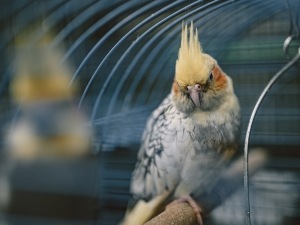
Cockatiels usually have white, grey, and yellow feathers and/or a grey beak. The bird’s appearance may stray from this and look slightly different but not often.
This article is a look into why your cockatiel’s beak has white spots.
Table of Contents
White spots on cockatiel beak:
Your cockatiels beak is one of its most important body parts, not only does it enable the bird to eat, it helps the bird communicate and clean itself as well, so it must always be in good condition.
Here is why there may be white spots on your cockatiels beak:
Wear and tear:
Beaks are used a lot, daily, by birds, so the beaks will inevitably suffer some wear and tear and this may be what you’re seeing.
Our human nails are made out of the same material that bird beaks are, keratin, this keratin is quite strong but is not impenetrable.
If your bird uses the beak roughly then the layers of the keratin on the bird’s beak may start to lift and this may be what you’re seeing as white patches or spots on your bird’s beak.
What to do:
This is quite normal and isn’t something that you’d need to worry about, it just means that your bird is using its beak a lot.
Because the keratin on your bird’s beak is always growing, the worn areas will eventually grow along with the rest of the bird’s beak to the tip of the beak.
The tip will be ground down as the bird does its everyday activities.
If this is becoming an issue for your bird, or you, then you can take your bird to the vet and they will grind the beak down, get rid of the white patches, and smooth the beak down to normal, but this isn’t necessary.
You can also help the bird grind its beak down by giving it a cuttlebone.
Not only does cuttlebone contain nutrients that help keep the bird healthy, your bird pecking at the cuttlebone helps keep the beak smooth by removing the outer layers of keratin from the bird beak. It also helps to support beak strength overall.
Scaly face mites:
If the white spots on your bird’s beak are chalky white and crusty then your bird may be suffering from scaly face mites.
These mites are microscopic in size and are related to spiders and ticks.
They can burrow almost anywhere on your bird’s body, your bird’s beak included. If they infect your bird’s beak then your bird may develop crusty white patches at the corner of its beak.
This condition can get so bad that it causes deformities in your bird’s beak because of all the burrowing and this damage may not be reversible so treating the bird is a must.
What to do:
You’d need to get your bird to the vet for treatment, once the vet has confirmed that your bird has scaly face mites he will offer a treatment that contains ivermectin.
The bird should recover after receiving several treatments over a number of days.
Treating all the birds you own, even the ones that don’t show symptoms, is recommended as signs of an infestation do not always show up immediately.
If you enjoyed this article then you may also be interested in other bird related articles. Here are some articles that you may be interested in: Baby Chick Wants To Be Held All The Time, Baby Chick Looks Wet, Baby Chick Screaming, Baby Chick Distress Call, Chicken Stuck On Back, Red Rash On Chickens Skin, Chickens With Red Skin, Baby Chick Laying Down With Wing Out, Baby Chick Won’t Walk Or Open Eyes?

